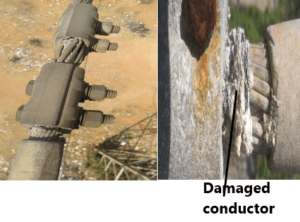Table of Contents
ToggleCase Study
During Line Patrolling it was observed with damage of Main conductor strands of the 132KV Line conductor.

Detail Observation
- During Annual Tower climbing detail observation works, it was found with damage of few strands of the main conductor at the mouth of the PG clamp as like shown in the fig.
- This Line was connected with Double jumpers and both the jumpers had been placed with connection of PG clamps
- The actual jumper cone had been damaged, for which PG clamp was put in the system.
- But the workmanship of putting the PG clamp was not to the mark due to intermittent gap in the overlapping groove of the PG clamp as seen from the fig.
- The other similar type case with use of PG clamp and damage of strands has been shown in fig .
- Moreover, both the PG Clamps were put nearby as shown here fig, over the twisted conductor strands .
Action Taken
- The Conductor was replaced with the new one on the allotted span.
2. Use of PG clamp was avoided. The actual Jumper cone was used for jumpering the line
Technical Analysis
- PG clamp manufacturing and finishing of the product depends upon the format used in the manufacturing site. Sometimes due to improper pouring of the slag and availability of foreign impurities result with issues on the overlapping groove.
- Due to this defect, the upper grip may not hold the lower one and during tightening of the bolts, if the work person does not do the correct tightening work, then its impact shall be on the strands of the conductor.
- Moreover, due to environmental factors like abnormal seasonal heating and cooling may cause deterioration.
- The deposition of water/moisture drops, dusts etc.. may cause rusting and cutting of the strands as like happened here.
- Then during current flow, this damage becomes more, resulting with gradual failure. But in this case the string has not failed due to internal Steel wire strength as this conductor was of ACSR Panther type.
